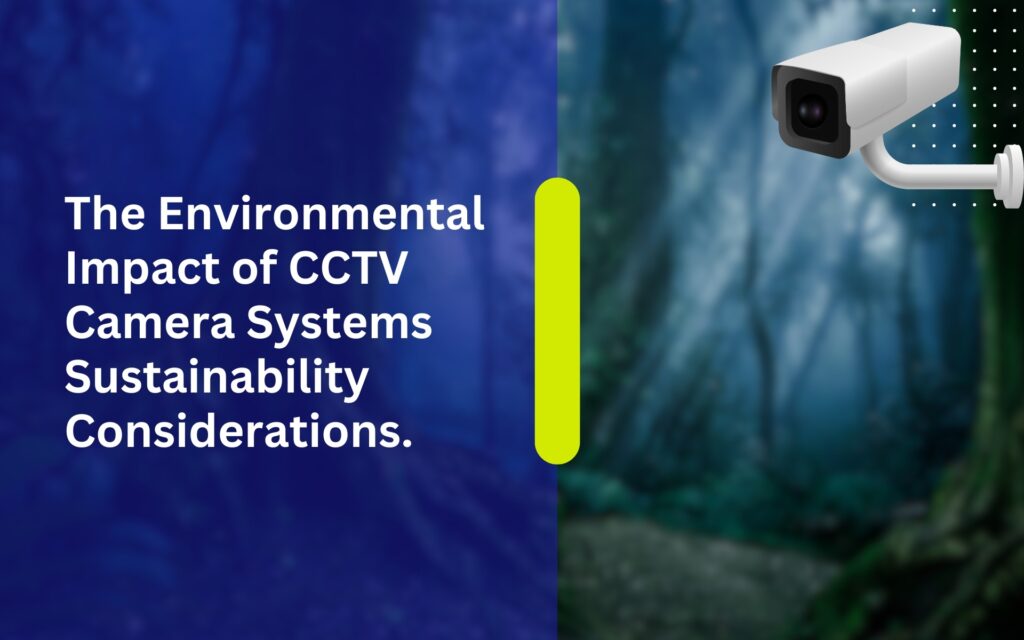Why you should have Fiber Cabling Installation? Introduction. In today’s fast-paced business environment, reliable and high-speed internet connectivity is no longer a luxury; it is a critical necessity for smooth operations and …
The Environmental Impact of CCTV Camera Systems Sustainability Considerations.

Introduction
In the modern era of technological advancements, Closed-Circuit Television (CCTV) camera systems have become integral components of surveillance, security, and monitoring infrastructure. From urban areas to rural landscapes, these systems are omnipresent, serving diverse purposes ranging from crime prevention to traffic management. However, amid their widespread adoption and utility, the environmental ramifications of CCTV camera systems often remain overlooked. This comprehensive exploration aims to delve deeply into the environmental impact of CCTV camera systems, elucidating sustainability considerations necessary for steering towards a greener future.
Chapter 1: Understanding CCTV Camera Systems
Before delving into their environmental footprint, it is imperative to grasp the intricacies of CCTV camera systems. These systems comprise an ensemble of components, including cameras, recording devices, monitors, and communication networks. CCTV cameras, the cornerstone of such systems, capture visual data, which is then transmitted, stored, and analyzed for surveillance purposes. Over time, the evolution from analog to digital CCTV systems has revolutionized the landscape, offering enhanced resolution, storage capabilities, and connectivity.
Chapter 2: Environmental Impact of CCTV Camera Systems
1. Energy Consumption
A significant environmental concern associated with CCTV camera systems is their voracious appetite for energy. Operating around the clock, these systems necessitate continuous power supply to sustain their functionalities. The energy-intensive nature of CCTV operations contributes to heightened electricity consumption, thereby amplifying carbon emissions and exacerbating climate change. Analog CCTV systems, in particular, notorious for their energy inefficiency, underscore the urgency of transitioning towards more sustainable alternatives.
2. Electronic Waste
The proliferation of CCTV systems has inadvertently fueled the generation of electronic waste (e-waste). As technological advancements render older systems obsolete, the disposal of outdated cameras, monitors, and recording devices escalates. Improper e-waste management poses grave threats to environmental integrity, as hazardous components leach toxins into soil and water bodies, endangering ecosystems and human health alike.
3. Resource Depletion
The manufacturing process of CCTV camera systems entails the extraction and utilization of finite natural resources. From metals and plastics to rare earth elements, the production cycle engenders habitat destruction, deforestation, and resource depletion. Moreover, the energy-intensive fabrication of electronic components exacts a toll on environmental sustainability, necessitating concerted efforts towards resource conservation and circular economy principles.
4. Carbon Footprint
A holistic assessment of the environmental impact of CCTV camera systems must encompass their entire lifecycle, from inception to disposal. Carbon emissions, stemming from manufacturing, transportation, installation, operation, and eventual decommissioning, collectively contribute to the system’s carbon footprint. By adopting a lifecycle approach and mitigating emissions across each stage, stakeholders can attenuate the environmental burden imposed by CCTV infrastructure.
Chapter 3: Sustainability Considerations
1. Energy Efficiency
Mitigating the energy consumption of CCTV camera systems necessitates a paradigm shift towards energy-efficient technologies. Manufacturers can leverage innovations such as low-power components, motion sensors, and adaptive lighting to curtail energy wastage. Furthermore, integrating renewable energy sources, such as solar and wind power, can augment the sustainability quotient of CCTV operations, paving the way for greener surveillance solutions.
2. Lifecycle Management
Adopting a circular economy approach is imperative for optimizing resource utilization and minimizing e-waste generation. Designing modular components that facilitate repair, refurbishment, and recycling can extend the lifespan of CCTV systems while reducing environmental impact. Additionally, incentivizing customers to participate in take-back programs and adhering to e-waste regulations can foster a culture of responsible consumption and disposal.
3. Sustainable Materials
Embracing sustainable materials in the design and manufacturing of CCTV camera systems holds the key to mitigating resource depletion and environmental degradation. From recycled plastics to responsibly sourced metals, the integration of eco-friendly materials can enhance product longevity and minimize ecological footprint. Moreover, exploring alternatives to rare earth elements and toxic chemicals can bolster product sustainability and safety standards.
4. Smart Technology Integration
Harnessing the power of artificial intelligence (AI) and machine learning can optimize the efficiency and efficacy of CCTV camera systems. Smart technologies, including video analytics, predictive maintenance, and automated monitoring, can streamline operations, reduce false alarms, and mitigate energy consumption. By embracing smart technology integration, stakeholders can unlock new avenues for sustainability and innovation in the realm of surveillance.
5. End-of-Life Management
Proper disposal and recycling of end-of-life CCTV equipment are pivotal for closing the loop on resource utilization and minimizing environmental impact. Establishing robust take-back programs, partnering with certified e-waste recyclers, and adhering to regulatory frameworks can ensure responsible disposal practices. Moreover, fostering a culture of awareness and accountability among consumers is essential for promoting sustainable consumption patterns and waste management practices.
Conclusion
In conclusion, the environmental impact of CCTV camera systems transcends mere surveillance infrastructure, encompassing a myriad of ecological considerations. By comprehensively analyzing their energy consumption, e-waste generation, resource utilization, and carbon footprint, stakeholders can chart a course towards sustainability and resilience. Through concerted efforts to integrate energy-efficient technologies, adopt circular economy principles, embrace sustainable materials, leverage smart technology, and implement responsible end-of-life management practices, the environmental footprint of CCTV systems can be mitigated. As we navigate towards a greener future, collaboration among manufacturers, policymakers, consumers, and environmental advocates is paramount for effecting meaningful change. By prioritizing environmental stewardship and sustainability in the realm of surveillance infrastructure, we can pave the way for a more harmonious coexistence between technology and the environment.
Related Articles
The On-the-Job Training Experience of Rochie Mae Monterde. Introduction As a Sales Intern, Rochie Mae Monterde dedicated her 250-hour On-the-Job Training to supporting the sales department in its day-to-day operations. Her role …
The On-the-Job Training Experience of Farlie Miz E. Catubay. Introduction As a Technical Support Intern, Farlie Miz E. Catubay dedicated her 600-hour On-the-Job Training to assisting the technical team during onsite projects …
